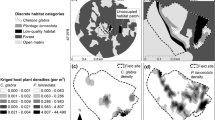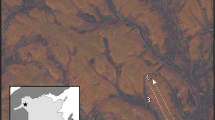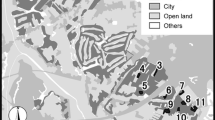Abstract
Understanding animal responses to landscape elements helps forecast population reactions to changing landscape conditions. The challenge is that some behaviors are poorly known and difficult to estimate. We assessed how uncertainty in behavioral responses to dense woods, an avoided landscape structure, impacts functional connectivity among reproductive habitat patches for Fender’s blue butterfly, an endangered prairie species of western Oregon, USA. We designed a factorial simulation experiment using a spatially explicit individual-based model to project functional connectivity for female butterflies across current and alternative landscapes. We varied the probability of dense woods entry and turning angle standard deviation for movements within the dense woods over a range of biologically reasonable and observed values. Butterflies in the current landscape (46 % dense woods) and one with prairie encroached by forest (60 % dense woods) showed reductions in functional connectivity estimates consistent with the expectations of habitat fragmentation. Although dense woods entrance uncertainty impacted functional connectivity projections, uncertainty in the dense woods turning angle standard deviation had comparatively little impact on connectivity estimates. Reduction and reconfiguration of the current dense woods to 27 % cover (restored landscape) appeared to facilitate a corridor behavior in dispersing individuals, likely providing a functional connectivity estimate comparable to the historic landscape (<5 % dense woods). Our simulations suggest that additional study of butterfly movement within the dense woods is unnecessary and that a partial reduction in dense woods would be sufficient to achieve historic levels of functional connectivity for Fender’s blue across the study landscape.





Similar content being viewed by others
References
Andersson E, Bodin O (2009) Practical tool for landscape planning? An empirical investigation of network based models of habitat fragmentation. Ecography 32:123–132
Arnold RA (1983) Ecological studies of six endangered butterflies (Lepidoptera, Lycaenidae). U Cal Pub Entomol 99:1–153
Baguette M, Van Dyck H (2007) Landscape connectivity and animal behavior: functional grain as a key determinant for dispersal. Landscape Ecol 22:1117–1129
Baum KA, Haynes KJ, Dillemuth FP, Cronin JT (2004) The matrix enhances the effectiveness of corridors and stepping stones. Ecology 85:2671–2676
Bélisle M (2005) Measuring landscape connectivity: the challenge of behavioral landscape ecology. Ecology 86:1988–1995
Breed GA, Jonsen ID, Myers RA, Bowen WD, Leonard ML (2009) Sex-specific, seasonal foraging tactics of adult grey seals (Halichoerus grypus) revealed by state-space analysis. Ecology 90:3209–3221
Bridge ES, Thorup K, Bowlin MS, Chilson PB, Diehl RH, Fleron RW, Hartl P, Kays R, Kelly JF, Robinson WD, Wikelski M (2011) Technology on the move: recent and forthcoming innovations for tracking migratory birds. BioSci 61:689–698
Cant ET, Smith AD, Reynolds DR, Osborne JL (2005) Tracking butterfly flight paths across the landscape with harmonic radar. Proc R Soc B: Biol Sci 272:785–790
Carleton A, Schultz CB (2012) Restoration action and species response: oviposition habits of Plebejus icarioides fenderi (Lepidoptera: Lycaenidae) across a restoration chronosequence. J Insect Conserv. doi:10.1007/s10841-012-9535-7
Castellόn TD, Sieving KE (2006) An experimental test of matrix permeability and corridor use by an endemic understory bird. Conserv Biol 20:135–145
Christy JA, Alverson ER (2011) Historical vegetation of the Willamette Valley, Oregon, circa 1850. Northwest Sci 85:93–107
Dennis RLH, Shreeve TG, Van Dyck H (2006) Habitats and resources: the need for a resource-based definition to conserve butterflies. Biodivers Conserv 15:1943–1966
Douglas-Hamilton I, Krink T, Vollrath F (2005) Movements and corridors of African elephants in relation to protected areas. Naturwissenschaften 92:158–163
Dover JW, Fry GLA (2001) Experimental simulation of some visual and physical components of a hedge and the effects of butterfly behavior in an agricultural landscape. Entomol Exp Appl 100:221–233
Dover J, Settele J (2009) The influences of landscape structure on butterfly distribution and movement: a review. J Insect Conserv 13:3–27
Eigenbrod F, Hecnar SJ, Fahrig L (2011) Sub-optimal study design has major impacts on landscape-scale inference. Biol Conserv 144:298–305
Fahrig L (2007) Non-optimal animal movement in human-altered landscapes. Funct Ecol 21:1003–1015
Fall A, Fall JG (2001) A domain-specific language for models of landscape dynamics. Ecol Model 141:1–18
Fischer J, Lindenmayer DB (2007) Landscape modification and habitat fragmentation: a synthesis. Global Ecol Biogeogr 16:265–280
Fudickar AM, Wikelski M, Partecke J (2011) Tracking migratory songbirds: accuracy of light-level loggers (geolocators) in forest habitats. Methods Ecol Evol 3:47–52
Goodwin BJ, Fahrig L (2002) How does landscape structure influence landscape connectivity? Oikos 99:552–570
Graf RF, Kramer-Schadt S, Fernández N, Grimm V (2007) What you see is where you go? Modeling dispersal in mountain landscapes. Landscape Ecol 22:853–866
Haddad NM (1999) Corridor use predicted from behaviors at habitat boundaries. Am Nat 153:215–227
Hagan M, Wikelski M, Kissling WD (2011) Space use of bumblebees (Bombus spp.) revealed by radio tracking. PLoS ONE 6:e19997
Hanski I (1998) Metapopulation dynamics. Nature 396:41–49
Hawkes C (2009) Linking movement behaviour, dispersal and population processes: is individual variation the key? J Anim Ecol 78:894–906
Johannessen CL, Davenport WA, Millet A, McWilliams S (1970) The vegetation of the Willamette Valley. Ann Assoc Am Geograph 61:286–302
Kindlmann P, Burel F (2008) Connectivity measures: a review. Landscape Ecol 23:879–890
Knowlton JL, Graham CH (2010) Using behavioral landscape ecology to predict species’ responses to land-use and climate change. Biol Conserv 143:1342–1354
Lima SL, Zollner PA (1996) Towards a behavioral ecology of ecological landscapes. Trends Ecol Evol 11:131–135
Marucco F, McIntire EJB (2010) Predicting spatio-temporal recolonization of large carnivore populations and livestock depredation risk: wolves in the Italian Alps. J Appl Ecol 47:789–798
McIntire EJB, Schultz CB, Crone EE (2007) Designing a network for butterfly habitat restoration: where individuals, populations and landscapes interact. J Appl Ecol 44:725–736
McIntire EJB, Rompré G, Severns PM (2013) Biased correlated random walk and foray loop: which movement hypothesis drives a butterfly metapopulation? Oecologia. doi:10.1007/s00442-012-2475-9
Moilanen A, Hanski I (2001) On the use of connectivity measures in spatial ecology. Oikos 95:147–151
Mooij WM, DeAngelis DL (2003) Uncertainty in spatially explicit animal dispersal models. Ecol Appl 13:794–805
Nathan R, Getz WM, Revilla E, Holyoak M, Kadmon R, Saltz D, Smouse PE (2008) A movement ecology paradigm for unifying organismal movement research. Proc Nat Acad Sci 105:19052–19059
Ovaskainen O, Luoto M, Ikonen I, Rekola H, Meyke E, Kuussaari M (2008) An empirical test of a diffusion model: predicting clouded apollo movements in a novel environment. Am Nat 171:610–619
Pe’er G, Kramer-Schadt S (2008) Incorporating the perceptual range of animals into connectivity models. Ecol Model 213:73–85
Pe’er G, Saltz D, Frank K (2005) Virtual corridors for conservation management. Conserv Biol 19:1997–2003
Prevedello JA, Vieira MV (2010) Does the type of matrix matter? A quantitative review of the evidence. Biodivers Conserv 19:1205–1233
Prevedello JA, Forero-Medina G, Vieira MV (2010) Movement behavior within and beyond perceptual ranges in three small mammals: effects of matrix type and body mass. J Anim Ecol 79:1315–1323
Reuter H, Breckling B, Jopp F (2011) Individual-based models. In: Jopp F, Reuter H, Breckling B (eds) Modelling complex ecological dynamics. Springer, Berlin, pp 163–178
Revilla E, Wiegand T (2008) Individual movement behavior, matrix heterogeneity, and the dynamics of spatially structured populations. Proc Nat Acad Sci 105:19120–19125
Revilla E, Wiegand T, Palomares F, Ferreras P, Delibes M (2004) Effects of matrix heterogeneity on animal dispersal: from individual behavior to metapopulation-level parameters. Am Nat 164:E130–E153
Ricketts TH (2001) The matrix matters: effective isolation in fragmented landscapes. Am Nat 158:87–99
Ries L, Fletcher RJ Jr, Battin J, Sisk TD (2004) Ecological responses to habitat edges: mechanisms, models, and variation explained. Ann Rev Ecol Evol Syst 34:491–522
Schofield G, Hobson VJ, Fossette S, Lilley MKS, Katselidis KA, Hays GC (2010) Fidelity to foraging sites, consistency of migration routes and habitat modulation of home range by sea turtles. Divers Distr 16:840–853
Schooley RL, Wiens JA (2003) Finding habitat patches and functional connectivity. Oikos 102:559–570
Schultz CB (1998) Dispersal behavior and its implications for reserve design in a rare Oregon butterfly. Conserv Biol 12:284–292
Schultz CB (2001) Restoring resources for an endangered butterfly. J Appl Ecol 38:1007–1019
Schultz CB, Crone EE (2001) Edge-mediated dispersal behavior in a prairie butterfly. Ecology 7:1879–1892
Schultz CB, Crone EE (2005) Patch size and connectivity thresholds for butterfly habitat restoration. Conserv Biol 19:887–896
Schultz CB, Hammond PC, Wilson MV (2003) The biology of Fender’s blue butterfly (Icaricia icarioides fenderi), an endangered species of western Oregon native prairies. Nat Areas J 23:61–71
Schultz CB, Franco AMA, Crone EE (2012) Response of butterflies to structural and resource boundaries. J Anim Ecol 81:724–734
Severns PM (2003) Propagation of a long-lived and threatened prairie plant Lupinus sulphureus ssp. kincaidii. Restor Ecol 11:334–342
Severns PM (2008a) Exotic grass invasion impacts fitness of an endangered prairie butterfly, Icaricia icarioides fenderi. J Insect Conserv 12:651–661
Severns PM (2008b) Road crossing behavior of an endangered grassland butterfly, Icaricia icarioides fenderi Macy (Lycaenidae), between a subdivided population. J Lepid Soc 62:55–58
Severns PM, Warren AD (2008) Saving an imperiled butterfly, Euphydryas editha taylori (Taylor’s checkerspot), by selectively conserving and eliminating exotic plants. Anim Conserv 11:476–483
Shapiro AM (2002) The Californian urban butterfly fauna is dependent on alien plants. Divers Distrib 8:31–40
Shochat E, Patten MA, Morris DW, Reinking DL, Wolfe DH, Sherrod SK (2005) Ecological traps in isodars: effects of tallgrass prairie management on bird nest success. Oikos 111:159–169
Summerville KS, Veech JA, Crist TO (2002) Does variation in patch use among butterfly species contribute to nestedness at fine spatial scales? Oikos 97:195–204
Tepedino VJ, Bradley BA, Griswald TL (2008) Might flowers of invasive plants increase native bee diversity? Intimations from Capitol Reef National Park, Utah. Nat Areas J 28:44–49
Tischendorf L, Fahrig L (2000) On the usage and measurement of landscape connectivity. Oikos 90:7–19
Tscharntke T, Steffan-Dewenter I, Kruess A, Thies C (2002) Characteristics of insect populations on habitat fragments: a mini review. Ecol Res 17:229–239
Turchin P (1998) Quantitative analysis of movement: measuring and modeling population redistribution in animals and plants. Sinauer Associates
Turlure C, Baguette M, Stevens VM, Maes D (2011) Species- and sex-specific adjustments of movement behavior to landscape heterogeneity in butterflies. Behav Ecol 22:967–975
Uezu A, Metzger JP, Vielliard JME (2005) Effects of structural and functional connectivity and patch size on the abundance of seven Atlantic forest bird species. Biol Conserv 123:507–519
United States Fish and Wildlife Service (2010) Recovery plan for the prairie species of western Oregon and southwestern Washington U.S. Fish and Wildlife Service, Portland, Oregon
Valentine-Darby PL, Darby PC, Percival HF (2011) Gender-based differences in Florida apple snail (Pomacea paludosa) movements. Malacologia 54:109–118
Van Dyck H, Baguette M (2005) Dispersal behaviour in fragmented landscapes: routine or special movements? Basic Appl Ecol 6:535–545
Vos CC, Berry P, Opdam P, Baveco H, Nijhof B, O’Hanley J, Bell C, Kuipers H (2008) Adapting landscapes to climate change: examples of climate-proof ecosystem networks and priority adaptation zones. J Appl Ecol 45:1722–1731
Wikelski M, Moskowitz D, Adelman JS, Cochran J, Wilcove DS, May ML (2006) Simple rules guide dragonfly migration. Biol Lett 2:325–329
Wikelski M, Kays RW, Kasdin NJ, Thorup K, Smith JA, Swenson GW (2007) Going wild: what a global small-animal tracking system could do for experimental biologists. J Exp Biol 210:181–186
Wilson MV, Erhart T, Hammond PC, Kaye TN, Kuykendall K, Liston A, Robinson AF Jr, Schultz CB, Severns PM (2003) The biology of Kincaid’s lupine (Lupinus sulphureus ssp. kincaidii), a threatened species of western Oregon native prairies. Nat Areas J 23:72–83
Acknowledgments
We thank the Cardwell Hills private landowners (Charlie and Rich Clark, PK and Dai Crisp, Karen Fleck-Harding, Lorin and Josh Lidell, William Pearcy, and Amy Schoener) for enabling the study of Fender’s blue butterflies on their properties. Without their help, cooperation and commitment to conservation this research would not have been possible. We thank Elizabeth Crone for helpful conversations and feedback throughout the project, two anonymous reviewers and C. Vos provided thoughtful comments that improved this manuscript. This project was financially supported by the US Fish and Wildlife Service, Strategic Environmental Research and Development Program (SERDP), Washington State University Vancouver, the Natural Science and Engineering Research Council of Canada Discovery Grant and the Canada Research Chair program.
Author information
Authors and Affiliations
Corresponding author
Rights and permissions
About this article
Cite this article
Severns, P.M., McIntire, E.J.B. & Schultz, C.B. Evaluating functional connectivity with matrix behavior uncertainty for an endangered butterfly. Landscape Ecol 28, 559–569 (2013). https://doi.org/10.1007/s10980-013-9860-6
Received:
Accepted:
Published:
Issue Date:
DOI: https://doi.org/10.1007/s10980-013-9860-6




